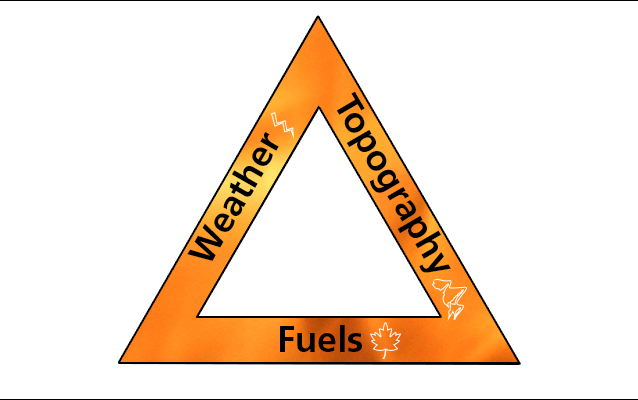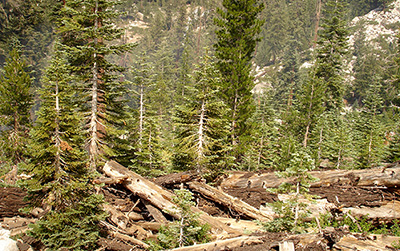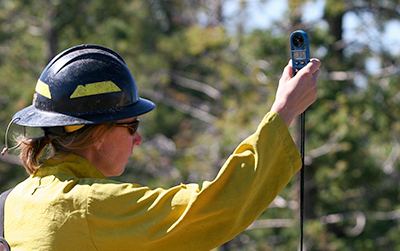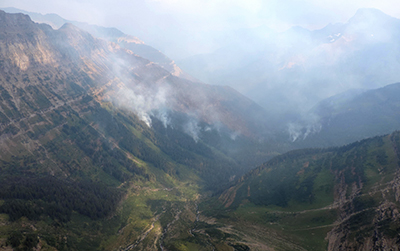This article is part of the Wildland Fire Learning In Depth series. It is designed for students who want to learn more about fire. Find the complete series on the Fire subject site.

NPS/C. BOEHLE
Fire is influenced by many factors, including geography, climate, weather, and topography.
Season Matters
Though a wildfire can happen anytime the conditions are right, the time of year influences the effects of fire. For example, wildland fire season in the western United States is June through October, while March through May is the fire season in the southeastern United States. Most fires in the New England states occur in late fall. During some seasons, more moisture is present than in other seasons, thus reducing fire threat. This varies by geographic region.
The Fire Behavior Triangle
Just like there is a fire triangle, made up of heat, oxygen, and fuel, there is another triangle called the fire behavior triangle. The three legs of this triangle are fuels, weather, and topography. The sections below go more in depth into each of thise and their influence on fire.
Fuels

NPS
A fuel’s composition, including moisture level, chemical makeup, and density, determines its degree of flammability. Moisture level is the most important consideration. Live trees usually contain a great deal of moisture and dead logs contain very little. The moisture content and distribution of these fuels define how quickly a fire can spread and how intense or hot a fire may become. High moisture content will slow the burning process, because heat from the fire must first eliminate moisture.
In addition to moisture, a fuel’s chemical makeup determines how readily it will burn. Some plants, shrubs, and trees contain oils or resins that promote combustion, causing them to burn more easily, quickly, or intensely than those without such oils. Finally, density of a fuel influences its flammability. If fuel particles are close together, they will ignite each other, causing the fuel to burn readily. But if fuel particles are so close that air cannot circulate easily, the fuel will not burn freely.
Soil types also must be considered because fire affects the environment above and below the surface. Soil moisture content, the amount of organic matter present, and the duration of the fire determine to what extent fire will affect soil.
Weather

NPS/D. NG
Weather conditions such as wind, temperature, and humidity also contribute to fire behavior. Wind is one of the most important factors because it can bring a fresh supply of oxygen to the fire and push the fire toward a new fuel source.
Temperature of fuels is determined by the ambient temperature because fuels attain their heat by absorbing surrounding solar radiation. The temperature of a fuel influences its susceptibility to ignition. In general, fuels will ignite more readily at high temperatures than at low temperatures.
Humidity, the amount of water vapor in the air, affects the moisture level of a fuel. At low humidity levels, fuels become dry and, therefore, catch fire more easily and burn more quickly than when humidity levels are high.
Topography

NPS
Topography describes land shape. It can include descriptions of elevation with the height above sea level; slope, the steepness of the land; aspect, the direction a slope faces (e.g., the south side of a canyon will have a north-facing slope); features, such as canyons, valleys, rivers, etc.
These topographical features can help or hinder the spread of fire. For example, a rocky slope can act as a great natural fire break due to a lack of fuel and wide gap of open space. Drainages can act as fire breaks, as well if fuels are moist or there is little vegetation. Beyond the shape of the land, it is also important to consider elevation, slope, and aspect. Elevation and aspect can determine how hot and dry a given area will be. For example, higher elevations will be drier but colder than low ones, and a north-facing slope will be slower to heat up or dry out). Slope can determine how quickly a fire will move up or down hills. For example, if a fire ignites at the bottom of a steep slope, it will spread much more quickly upwards because it can pre-heat the upcoming fuels with rising hot air, and upward drafts are more likely to create spot fires.
Part of a series of articles titled Wildland Fire - Learning In Depth.
Last updated: February 16, 2017
